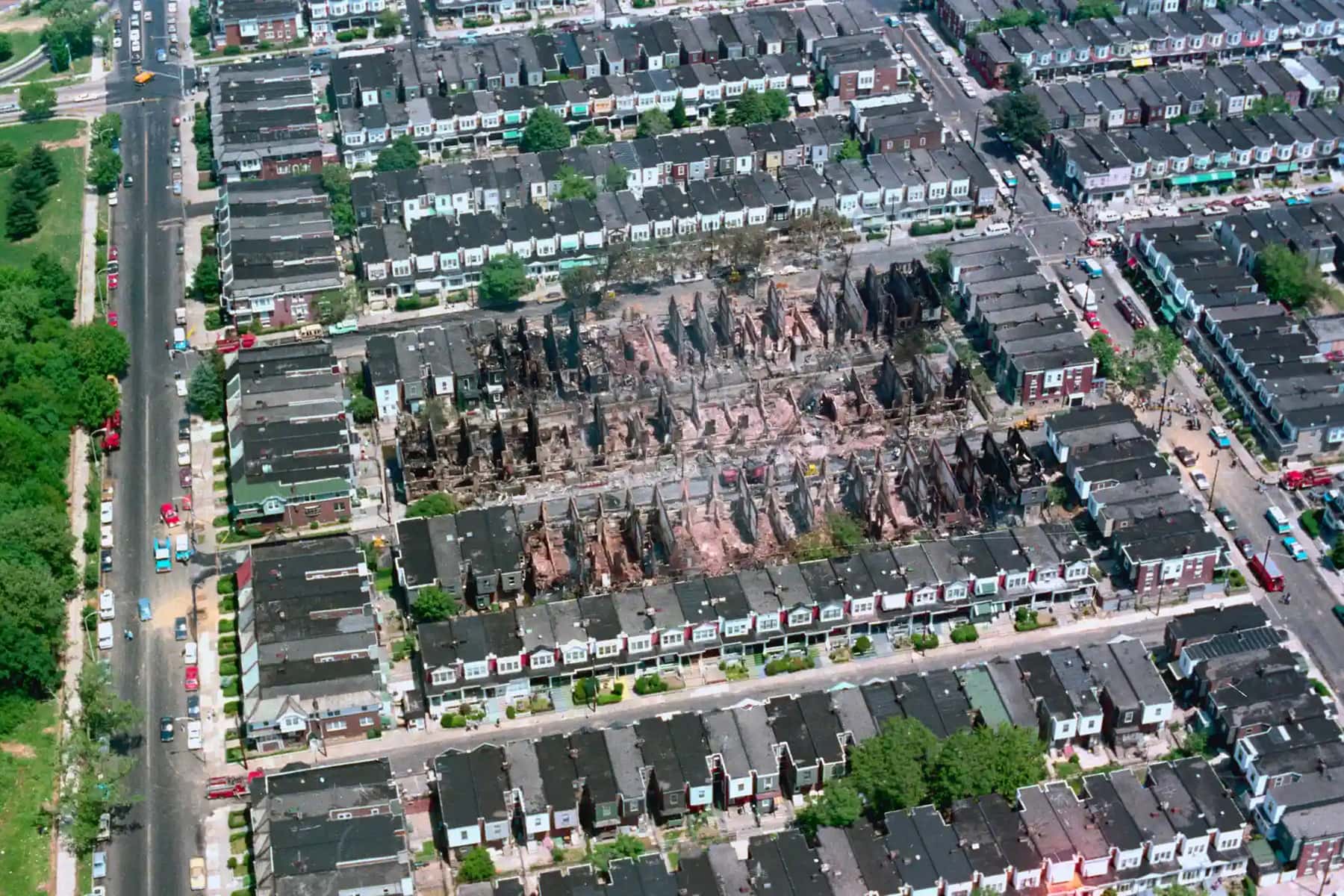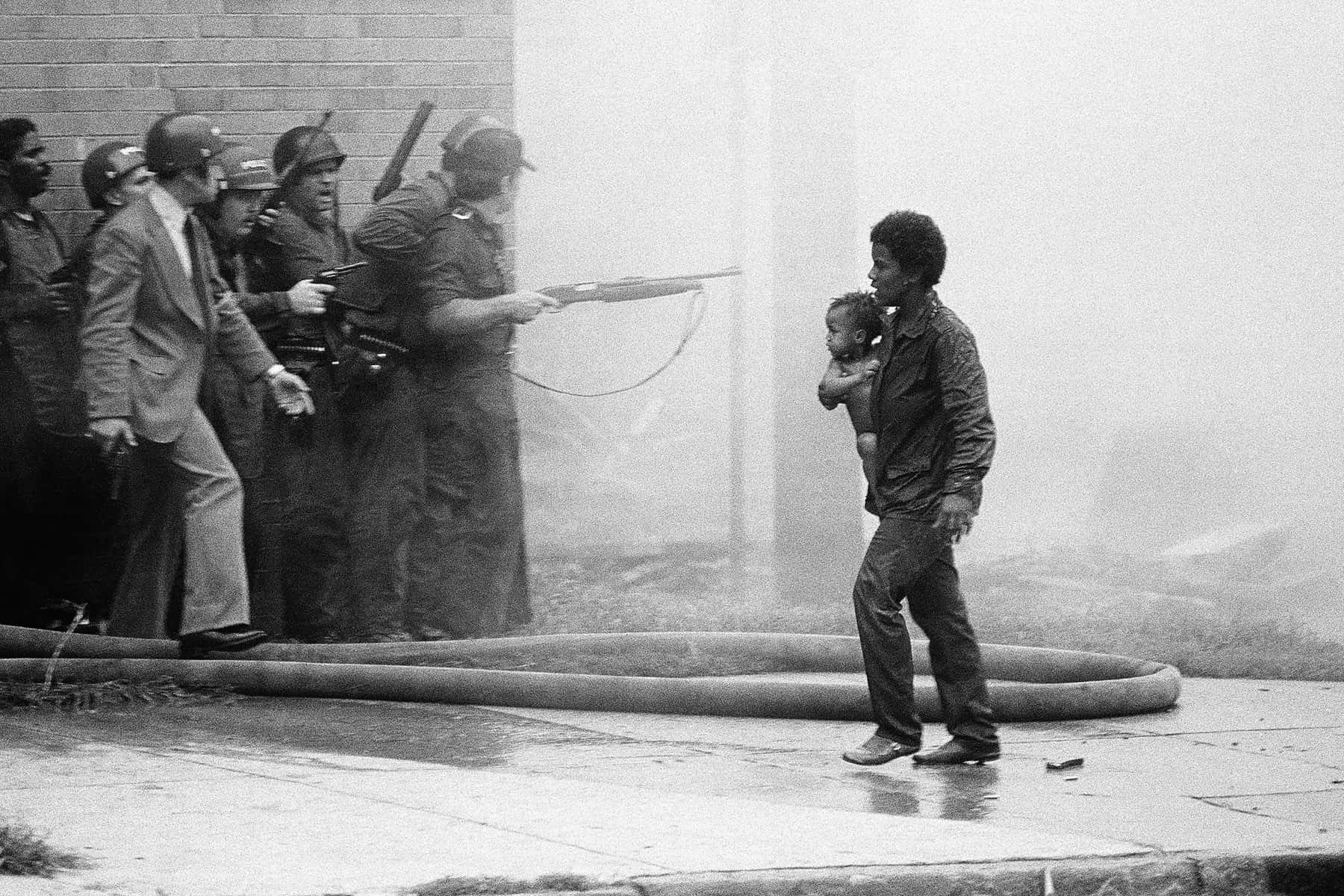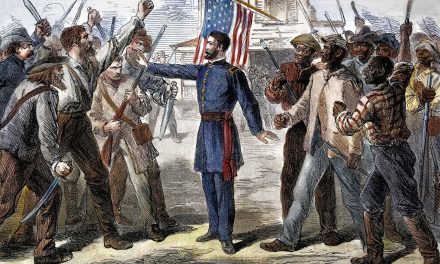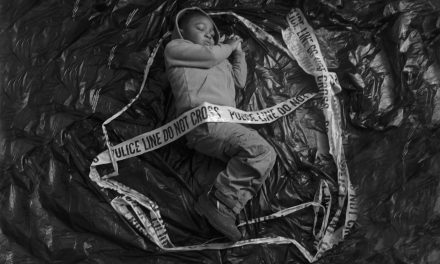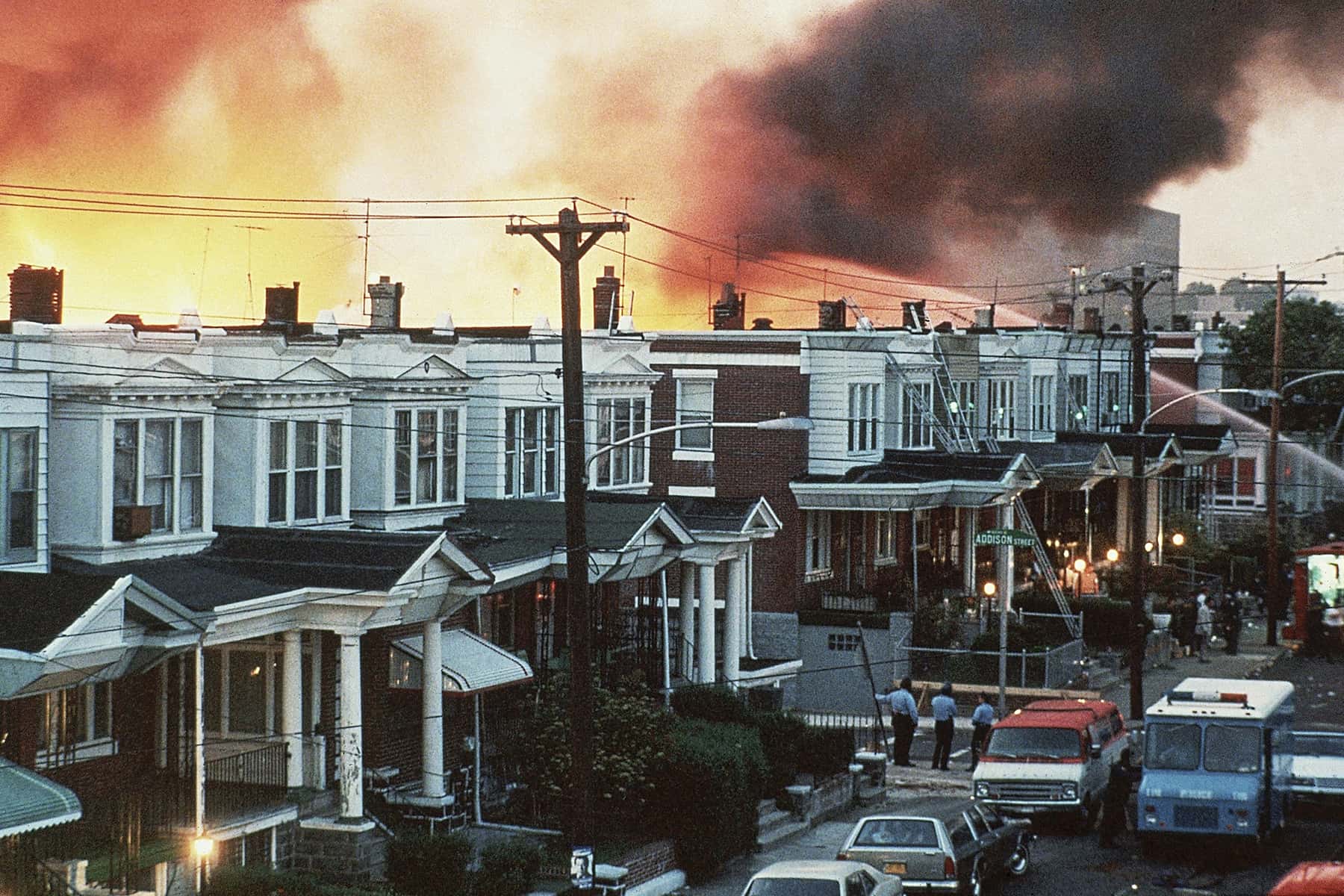
In the days ahead, Americans will hear the ugly details of the most infamous anti-black race riot in the nation’s history. The Tulsa Race Massacre, which will have its 100th anniversary commemorated on May 31, was the first case of an American city being bombed from the air. Most have never heard of the second case of a mainland American city being bombed from the air. It occurred in May 1985 in Philadelphia. An organization of Blacks called MOVE, who wanted to have nothing to do with the America that existed in Philadelphia at that time, had their compound bombed by Philadelphia police officials. The story is complicated and requires a telling of the backstory. These two articles tell the backstory and illuminates the events of May 13, 1985 when the bomb was dropped on their home, killing eleven members of MOVE including five children.
“MOVE is nothing special. They’ve gotten away with it because we’re compassionate and we don’t want to hurt innocent people, particularly the children… We’ll do everything we can to come to a peaceful ending.” – Frank Rizzo, Mayor of Philadelphia
“You are dealing with criminals, barbarians, you are safer in the jungle!” – Frank Rizzo, Mayor of Philadelphia
“They were looking for blood. They wanted to spill blood. They wanted to exterminate MOVE people.” – Jerry Africa
MOVE relocated to a new row house in 1981. After further confrontations with neighbors and more legal problems, four MOVE members were charged with crimes including making threats, parole violation, contempt of court and illegal possession of firearms. The mayor and police commissioner labeled them a terrorist group.
Three FBI agents were invited by Police Commissioner Gregore Sambor to attend a planning meeting of how the Philadelphia Police Department planned to use a tactical assault to extract the MOVE members from their residence at 6221 Osage Avenue.
“The basic plan involved announcing the eviction notice to MOVE, with the fire department to the roof of the house with water in an effort to knock down the bunkers built thereon. Simultaneously, two assault teams would enter the row houses on either side of the MOVE house… Upon entry into the row houses on either side of the MOVE residence, the assault teams intended to use explosives in a shaped charge configuration to punch small holes into the common wall of the row houses, thereby gaining entry into the MOVE house. Tear gas generators… would then be introduced into the small holes in the MOVE house walls, walls both in the basement and second floor. It was believed this action would force the occupants to the first (ground) floor, and then eventually forcing them to flee the house whereby they would be apprehended. Commissioner Sambor stressed there would be no manned entry into the MOVE house where any possibility existed that a policemen might be fired upon.”
Evacuation of the neighborhood began on the morning of Sunday May 12. Neighbors were told they would be back in their homes the following day. Fire department engines with water cannons were brought to the area at 3:00 a.m. on May 13. Over 500 police officers were stationed in the neighborhood.
By 6:10 a.m. gunfire between police and MOVE members began. This continued throughout the day and the Fire Department was ordered to use their fire cannons sporadically. The police would fire more than 10,000 rounds of ammunition in less than 90 minutes into the MOVE home. Eventually a police helicopter arrived on the scene. By the late afternoon, the thirteen MOVE members still refused to leave the home.
Police Commissioner Sambore ordered a bomb to be dropped on the house. At just after 5:22 p.m. a Pennsylvania State Police helicopter made three passes over the MOVE house. On the third pass, Philadelphia Police Department Lt. Frank Powell dropped two one pound bombs on the roof at 5:27 p.m. The explosion from the bombs ignited a fire which eventually killed eleven of the thirteen members of MOVE and spread to nearby houses, destroying 60 other homes.
The bombs were made of “Tovex TR-2” water gel made by DuPont, an explosive also known as C-4. The company described it as “a small diameter product that is very effective and equivalent to dynamite in performance.” The initial explosion damaged at least two other homes according to interviews by members of the team that dropped the bombs on the MOVE house.
The same firemen who had sprayed water cannons on the MOVE home for most of the day refused to put out the fire in the first hour after the bomb was dropped under orders from their superiors. The fire would eventually engulf and destroy the entire block as well as homes on two adjacent blocks.
By 5:49 p.m. the fire had spread to the home next door as evidenced by photographs taken from a State Police helicopter. As the fire grew, the roof of the MOVE house collapsed onto the second floor of the home. Shortly afterwards the second floor collapsed into the first floor. It was not until 6:30 p.m. a full hour and three minutes after the bombs were dropped, until firefighters turned on water hoses to attempt to put the fire out. By then, it had already spread to multiple neighboring houses. The fire spread rapidly to the east and west engulfing dozens of homes. Eventually it spread north and south as well.
The fire destroyed homes on three separate blocks. At 6:52 p.m. local news reported that only one fire hose was in operation, near the back of the MOVE house. By 7:30 p.m. the State Police helicopter flew over the MOVE house and reported at least seven homes on fire including two that were totally engulfed in flames. By 8:10 p.m. they flew over the area again and reported that every house on the block except four of them were on fire.
“The fire progressed from origin to involve 16 houses on the north side of Osage Avenue, 19 houses on the south side of Osage Avenue, 19 houses on the south side of Pine Street, 3 houses on the north side of Pine Street and 2 houses on the North side Addison Street, where it was confined.” – FBI report
The fires were not contained fully contained until 4:30 a.m. on May 14 after destroying 61 homes leaving over 250 people homeless.
“When I heard that they used an incendiary device on the roof, I was amazed, because you could clearly see drums of oil up there. And it would seem to me to have been lunacy under those circumstances to drop an incendiary device. But they did. And as the afternoon rolled on and the fire started, it became almost a holocaust.” – Ed Rendell, District Attorney
Over the course of the next two days 11 victims bodies were recovered from the MOVE house including six adults and five children. An FBI map shows that nine of the eleven victims were found bunched together in a corner of the garage. None of the articles at the time listed the victims names and many news articles since then have listed the number of people who died in the fires and the only name generally mentioned is the group’s founder John Africa. Six bodies were recovered from the home on May 14 and the remaining five the following day.
I was able to find an obscure FBI report dated May 24, 1985 which listed the victims but only named those who had been identified at the time. The were: 36-year-old James Africa, 26-year-old Theresa Africa, 10-year-old Tomasa Boo Africa, 30-year-old Rhonda Africa, 26-year-old Frank Africa, and 49-year-old Raymond Africa as well as three unidentified Black females and two unidentified Black males presumably the other four children killed (11-year-old boy, 13-year-old girl, 7-year-old girl, girl unknown age) in the fire as well as the MOVE founder, John Africa. I found another FBI report with autopsy documents from the Medical Examiner’s office which listed these other victims: 8-year-old Boo Africa, and an unnamed female girl of “pubertal age.” Tomasa “Boo” Africa was either eight or ten-years old.
The confirmed names of victims by MOVE did not match those from the original FBI lists. The six adults killed were John Africa, Rhonda Africa, Theresa Africa, Frank Africa, Conrad Africa and Raymond Africa. The children killed were 14-year-old Katricia “Tree” Africa, 13-year-old Zanetta “Netta” Africa, 11-year-old Phil Africa, 10-year-old Tomasa “Boo” Africa and 7-year-old Delisha Africa.
Only two MOVE members escaped the fire; 13-year-old Birdie who sustained third-degree burns to his buttocks, cheeks and second-degree burns to his feet and 29-year-old Ramona Africa who had second-degree burns to her arms, legs and back. Both told authorities that police fired on anyone trying to escape the fire. Ramona was charged and convicted of inciting a riot and spent seven years in prison after her escape from the inferno.
“We tried several times to get out, but each time we were shot back into the house. This was a clear indication that they didn’t intend for any of us to survive that attack.” – Ramona Africa
Police Commissioner Gregore J. Sambor, who ordered the aerial bombing, resigned in November 1985. Nearly a year later on March 9, 1986 the Black Mayor, Woodrow Wilson Goode issued an apology saying, “For me, personally, May 13 was the most tragic day in my life. Each day I live with its memories. I think often of the five children and six adults who lost their lives. I wish that May 13 had never happened – but it did, and I am sorry for that.”
The Philadelphia Special Investigation Commission created by an executive order by Mayor Goode found the following in its nearly year long investigation.
“Mayor Goode’s policy toward Move was one of appeasement, non-confrontation and avoidance. The Managing Director and the city’s department heads failed to take any effective action on their own and, in fact, ordered their subordinates to refrain from taking action. The city administration discounted negotiation as a method of resolving the problem. Any attempted negotiations were haphazard and uncoordinated… The Mayor instructed the Police Commissioner to prepare and execute a tactical plan, under the supervision of the Managing Director. The Managing Director failed in that responsibility, and the Mayor allowed the Police Commissioner to proceed on his own… The Mayor, the Managing Director and the Police Commissioner specifically approved the use of explosives to blow three-inch holes in the party walls of 6221 Osage Avenue… The Mayor’s failure to call a halt to the operation on May 12, when he knew that children were in the house, was grossly negligent and clearly risked the lives of those children. The Managing Director and the Police Commissioner were grossly negligent and clearly risked the lives of the children by failing to take effective steps to detain them and by not forcefully recommending to the Mayor that the operation be halted when they knew, the evening of May 12, that the children were in the residence… The firing of over 10,000 rounds of ammunition in under 90 minutes at a row house containing children was clearly excessive and unreasonable. The failure of those responsible for the firing to control or stop such an excessive amount of force was unconscionable… Explosives were used against the Move house on the morning of May 13, 1985, which were excessive and life-threatening… The Mayor abdicated his responsibilities as a leader when, after midday, he permitted a clearly failed operation to continue which posed great risk to life and property…The plan to bomb the Move house was reckless, ill-conceived and hastily approved. Dropping a bomb on an occupied row house was unconscionable and should have been rejected out-of-hand… Police gunfire prevented some occupants of 6221 Osage Avenue from escaping from the burning house to the rear alley. Five children were killed during the confrontation on May 13, 1985. Their deaths appear to be unjustified homicides which should be investigated by a grand jury… The performance of the Medical Examiner’s Office was unprofessional and violated generally accepted practices for pathologists.”
A grand jury convened and in May 1988, cleared Mayor Goode and other top-level city officials of criminal liability for the deaths and the destruction of the sixty-one homes. The grand jury found by a 16-4 vote that they saw no evidence that anyone had acted with criminal intent, recklessness or negligence. They were critical of the mayor and his administration but did not find them criminally responsible.
“We do not exonerate the men responsible for this disaster. Rather than a vindication of those officials, this report should stand as a permanent record of their morally reprehensible behavior.” – Grand Jury report
The grand jury found the attack to be, “an epic of governmental incompetence…marked by political cowardice in its inception, inexperience in its planning and ineptitude in its execution…an amazing leadership void…terrible misjudgment” by Fire Commissioner William C. Richmond who told police the fire started by the bomb could be controlled. In the end no one was held accountable.
In May 1996, a Federal jury found the city liable for the fire, saying the city used excessive force and violated MOVE’s constitutional protection against unreasonable search and seizure. They ordered the city to pay $1.5 million to Ramona Africa, and the relatives of founder John Africa and his nephew Frank. Ramona Africa was awarded $400,000 for pain and suffering and $100,000 for disfigurement and burns suffered in the fire. In a really ridiculous ruling, they ordered former Fire Commissioner William Richmond and former Police Commissioner Gregore Sambor to pay $1 a week each for the next 11 years to Ramona Africa and the other plaintiffs.
No apology was issued until November 2020. Philadelphia City Council member Jamie Gauthier, sponsored a resolution apologizing for the events on May 13, 1985. She introduced the apology just days after the fatal police shooting of Walter Wallace Jr. less than a mile away from the site of the bombing of the MOVE home more than 35 years after the tragedy unfolded. MOVE did not accept the apology.
According to the Philadelphia Inquirer, “W. Wilson Goode Sr., who was mayor at the time, called on the city to issue a formal apology in an op-ed published by The Guardian before the 35th anniversary. ‘The event will remain on my conscience for the rest of my life,’ he wrote.”
In the minds of many from the Black community it brings back memories of the aerial bombing of the Greenwood section of Tulsa Oklahoma known by some as Black Wall Street back in 1921.
If the tragedy itself was not painful enough, this headline from the Washington Post on April 30, 2021 told of the continuing trauma suffered by MOVE:
“A Philly museum kept the bones of a Black child killed in a police bombing. Decades later, it’s apologizing.”
Mike Africa Jr. spoke to the Washington Post after the story came out. “Who would do something like this? And without permission, without consent from the parents? The victims, he added, “were people. They didn’t deserve to be bombed and then put in a lab to become research material.”
The remains of the child were held by the University of Pennsylvania and Princeton University over a period of years. The University of Pennsylvania used the remains in a case study for an anthropology class.
According to the Philadelphia Inquirer:
“The remains — a pelvic bone and part of a femur — were initially subjected to detailed analysis by Penn anthropology professor Alan Mann and kept at the Penn Museum…Mann took the remains with him when he joined Princeton’s faculty in 2001, but returned them to the Penn Museum in 2016…In recent years, another Penn anthropologist, Janet Monge, has shown the remains in instructional videos offered online by Princeton. Most recently, the Coursera videos were available for viewing in classes that began this week. Monge, a curator at the Penn Museum, titled her class “Real Bones: Adventures in Forensic Anthropology” and spoke of a MOVE “case study.” The remains were kept at the Penn Museum for the last five years. They were just returned to Professor Mann…”
This is just the latest sign of the inhumanity shown to the members of MOVE. Their story is rarely told and in most instances they have been accused of causing their own deaths. The victims have been consistently blamed for this police brutality. No one in authority in the city was ever held responsible for the bombing and deaths.
Much like Tulsa’s race massacre, the victims are crying out for respect and justice.
“We have to rise up and fight the system, and push for accountability, because if this system is allowed to do what they’re doing to us, and we do not push for accountability, what makes us believe that they will not do this again?” – Mike Africa Jr.
“All the while the city of Tulsa have unjustly used the names and stories of victims, like me. I am 107 years old and have never seen justice. I pray that one day I will. I have been blessed with a long life and have seen the best and worst of this country. I think about the horror inflicted upon Black people in this country every day.” – Viola Fletcher, oldest living survivor of Tulsa Race Massacre
J. Scоtt Аpplеwhіtе, Pеtеr Mоrgаn, Lеіf Skооgfоrs, and Bеttmаnn Аrchіvе

